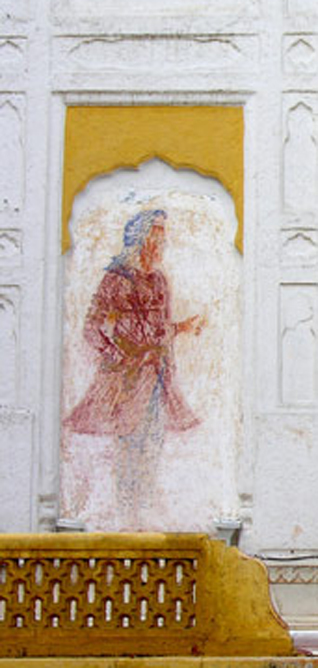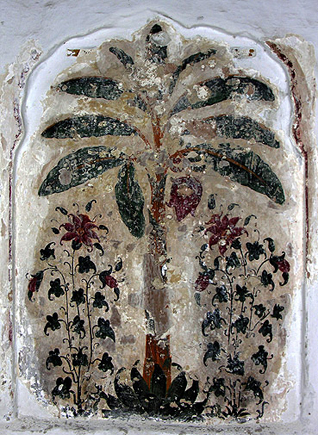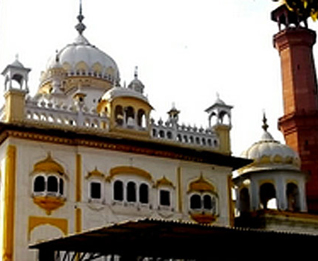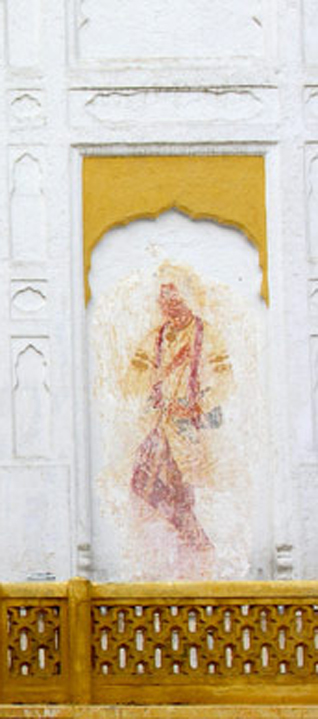
Images, above, and 1st from bottom: Frescoes buried under whitewash on the Ranjit Singh Samadhi.2nd from bottom: the Ranjit Singh Samadhi. 3rd from bottom: A frescoe from Kharak Singh's Samadhi.



Architecture
Pakistani Professor Discovers Sikh Heritage
BUSHRA SHEHZAD
When I learned that "Getting To Know Pre-Colonial Punjab Through Sikh-Period Frescoes", was being offered as an actual course at the Lahore university of Management Sciences (LUMNS) last semester, I was ecstatic.
It was my first encounter with the pioneering woman who has made it her life’s mission to document the largely undiscovered subject.
“I was roaming around the Lahore Fort when I came across the Athdara. I got on top of it and started looking around. I found several features that were Mughal but some were very different - a confusing but intriguing mix of materials and motifs,” remembers Dr Nadhra Shahbaz Naeem Khan.
This was the moment when her unique journey to documenting Sikh art and architecture in Pakistan began, which in her words, was “serendipity.”
Dr Khan graduated with a degree in graphic design from the Department of Fine Arts, University of the Punjab (presently the College of Art and Design) and completed her postgraduate in the same subject. Later, she taught at their Fine Arts Department for a few years before working for an advertising agency, and then joined the Lahore College for Women University, where she set up their Department of Art and Design.
In 2002, while Dr Khan was teaching Art and Design, the Punjab University announced a PhD programme in Art History. It was then that she says, she just “dived into it” without a very clear concept of where it would lead her.
A visit to the Athdara at the Lahore Fort triggered her destiny and took Dr Khan to Ranjit Singh’s Samadhi to discover and learn more.
“That was the day when I silently told myself that this was it - my dissertation was going to be on the Samadhi!”
Dr Khan’s PhD dissertation was a study of the ornamental program of Maharaja Ranjit Singh’s Samadhi in Lahore. This led her to study other Sikh monuments in Punjab. In the process, she has built an impressive photographic archive documenting some endangered sites - an area that needs more people like her to carry out specialised research given dire need of preserving and conserving heritage sites in Pakistan.
Performing documentation and research on historical sites in Pakistan is quite an arduous task, considering most of the monuments lie dilapidated, on the verge of being erased from history.
“The day I decided that this was what I wanted to take up as my research topic, I had no clue of what I was getting myself into.”
The first difficulties of this long and laborious journey started to surface when she failed to find any relevant published or archival work on the subject.
“I did not know where it all started from and except for small accounts by various 19th-century historians who briefly talk about Ranjit Singh; his pillaging of Mughal monuments and his Samadhi being a mix of Hindu and Muslim architectural elements, there was nothing else,” she says, expressing the hopelessness she felt at the time.
All the “desperately needed” material was in Amritsar and getting a visa to visit the land of the Maharaja’s contribution to the Golden Temple [complex] seemed impossible, until she met Manveen Sandhu and Tripat Bains, two charismatic Sikh women who opened the doors of the city, its research material as well as their hearts to Dr Khan.
Her voyage of research is a story as unique as her area of research. In the field, she is called the ‘scratching lady.’ Dr Khan says her “scratching project started with Maharaja Ranjit Singh’s Samadhi. The interior has beautiful panels of wall paintings and I was puzzled by the fact that the exterior was completely devoid of any.” This made her think that there was a strong possibility that these white washed walls originally may have had wall paintings.
But she says it was almost impossible to pinpoint as to where these paintings might have been. She then came across a late 19th-century black-and-white photograph by Bourne and Shepherd showing male figures flanking the northern entrance of the Samadhi, published by F. S. Ijazuddin in Lahore: Illustrated Views of the 19th Century, which led her to discover them being buried under thick layers of whitewash.
In a recent television news report on the Lahore Fort, the reporter mentioned: “And on this side, right outside the Roshnai Gate is Ranjit Singh’s Samadhi. And for those of you who do not know who Ranjit Singh is …” and she went on. I always thought Ranjit Singh’s depiction in our history books was exaggerated. Before I took up Dr Nadhra’s course, I had this image of Ranjit Singh as some bandit, who looted “our” Mughal buildings and ruled Punjab. I have been her student for a year now and every day I learn to see things from a new perspective. I wondered whether she had similar preconceived notions of these things as well?
“I embarked on my own project with these preconceived notions which were dispelled only much later. It happened gradually, as I met people across the border and studied and analysed history written by various historians giving different standpoints,” affirmed my professor.
Dr Khan feels particularly sad at how we, as a nation, have come to view history. “We look at history with lenses coloured with our bias. We need to take them off and bring in objectivity. We need to start owning our heritage. We need to look at it with pride, whether it is the Sikh period, the Mughal or the British. It is all part of us.”
She says we have developed this habit of looking at history from very specific angles. “This is Mughal, so this is ours; this belongs to another religion, so this isn’t. It should not be like this. We are heirs of an ancient culture and we need to understand it. Starting from the Indus Valley, anything and everything in this part of the world is what makes us who we are,” she adds with conviction.
I had never noticed the narratives from the Ramayana and the Mahabharata epic-myths beautifully painted in the sunken niches of the Sheesh Mahal at the Lahore Fort before I decided to write my research paper on Draupadi - a woman portrayed in the Mahabharata as the epitome of conviction and resilience.
And I wonder how many of us visiting the Lahore Fort know what these frescoes mean and signify - the majority probably just takes them as imaginary male and female figures painted merely for decorative purposes.
In Professor Nadhra’s opinion this is one of the major reasons so little is being done to preserve our heritage sites, “there is so little that people are aware of.”
Talking about Naunihal Singh’s Haveli, which now functions as the Victoria School, she says, “This reflects our ignorance as a nation.”
“The building needs to be vacated immediately. The school can operate in any of the surrounding buildings or houses,” Dr Khan adds as she laments over the almost faded Sikh monument. She stresses the need for government intervention, as she adds that of course one cannot deprive the students of their school.
The problem, she says, is that we are not trying to look at the long-term benefits of these buildings. “These buildings can become a source of huge benefit for our own people. They are not for one individual. This is important for our own people, every Pakistani. They also need to be familiar with their own heritage.”
Talking about the importance of conserving and preserving historical sites, she says that political stability comes when it has to come, but “one needs to bring economic stability and for this you have to work on many levels”. She adds, “This is one level where you can actually earn hundreds of millions for your people. The Sikhs yearn to come to Lahore, to visit their cultural heritage. They would do anything for a glimpse.”
Why can’t we take this opportunity and develop tourism, a huge industry that could benefit both individuals and the country, she asks.
Dr Khan believes more people need to be trained in this field, because there is so much to explore and learn. Her course at LUMS is an important step to create awareness but there is also urgency to preserve these endangered sites as they are fast decaying.
[Courtesy: Dawn. Edited for sikhchic.com]
May 25, 2012
Conversation about this article
1: Satvir Kaur (Boston, MA, U.S.A.), May 25, 2012, 11:32 AM.
It's the same on the other side of the border. We are not taking care of our own heritage on the Indian side. Kudos to those who care to spare their time and effort for this.
2: Sunny Grewal (Abbotsford, British Columbia, Canada), May 25, 2012, 3:35 PM.
It is nice to know that there are some Pakistanis who want to enjoy a secular version of their history. Unfortunately, radicalism in that part of the world and by extension its diaspora has contributed to the creation of a generation of Pakistanis who are arrogant enough to perpetuate the idea that a Sikh Raj never happened in the Punjab.
3: R. Singh (Surrey, British Columbia, Canada), May 25, 2012, 7:16 PM.
The Sikh Raj had the full support of the Muslim population of the time. Therefore, it was also very much a Punjabi Raj, led by a Sikh Maharaja who treated all communities equally.
4: Amarjeet Singh (Napier, New Zealand), May 25, 2012, 7:37 PM.
This is very pleasing to know; it can shed light on the days of the Sikh Raj as radicals in India are cooking up the myth that it was Marathas who ruled over India and present-day Pakistan.
5: R. Singh (Canada), May 25, 2012, 7:39 PM.
We are losing on both sides of the border. In India, we could easily have had Rajasthan-level of tourism, if the proper infrastructure had been set up. Thus our own palaces, forts and havelis are biting the dust.
6: Manpreet Singh Sidhu (India), May 26, 2012, 3:57 AM.
Glad to know that there are still some open-minded people in Pakistan. Sikh history seems to have been divided into two parts with the Partition of Punjab: before and after. The "before" left in Pakistan is being distorted, including Ranjit Singh's legacy. Most of the buildings have been stripped or torn down or lie in ruins, with the history creatively re-told. The "after" in India is going through distortions at the hands of the country's pseudo-nationalists, fundamentalists and right-wingers ...
7: Vic Singh Maan (Brampton, Ontario, Canada), May 26, 2012, 5:29 PM.
Acknowledging that Sikh history shares a common heritage with Pakistani Punjabis seems to me to be somehow incompatible with the Pakistani complex so controlled by Islam and so vehemently opposed to anything un-Islamic. I am wary that promotion of Sikh historical and cultural connections in Pakistan is solely a self interested ploy designed to stimulate a tourist economy rather than a genuine acceptance of not only the historical presence of Sikhs in the region but also an acceptance of Sikh influence in Pakistan's future. Will Pakistan be selling tickets to visitors to view its backyard or will Pakistan say to visitors that this is your backyard too? If the forced conversion of Rinkle Kumari to Islam so that she could marry her Muslim abductor is anything to go by, I think my concerns are justified.


